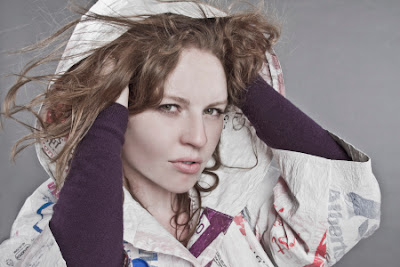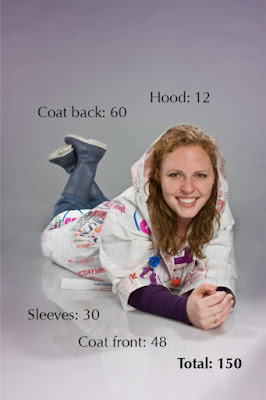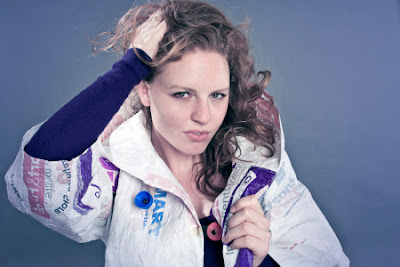A little background: The raincoat came about as a challenge from my thesis professor in design school. She assigned us the task of crafting an entry for the Cal Poly architecture department’s annual furniture show, Vellum, using only waste material. With my background as a seamstress I immediately knew I wanted to sew rather than putting in long hours in the wood or metal shop, and I was vaguely familiar with plarning which is essentially crocheting with a yarn made from strips of plastic grocery bags. After a few failed attempts at plarning anything of interest, I hunted around and found a tutorial for fusing layers of plastic bags with a low iron to make a textile able to be sewn with a sewing machine.
So there I sat in my studio with my first scrap of plastic fabric: a durable, waterproof application of a petroleum-based product that would otherwise go to landfill or destroy a habitat. My professor asked me what I was going to do with it. I threw out ideas for a sling style chair, or possibly using it for upholstery, before finally admitting that what I really wanted to do was make a fabulous raincoat out of it— because it’s so cool that it’s waterproof. She gave me the green light, and that’s how I ended up entering a raincoat in a furniture competition. (Someone else won, but I was the runner-up; thanks for asking.)
Constructing the coat was simple enough. The great thing about making my own textile was that I could fabricate pieces in the exact right sizes for my pattern pieces. I would also have some amount of control over where the logos ended up on the finished garment. I’m particularly proud of the closures: they are the necks and tops of soda bottles, and you actually screw them closed!
The challenge for me was how to present the coat and its message. So often in design, it seems having a product or project be “green” is an excuse to let it be clunky or non-functional. The prevailing notion seems to be that consumers should ‘buy green’ to ‘do the right thing’ or be imbued with a sense of righteousness for saving the world. My entire thesis was about consumerism and how to use great design to turn the ‘right thing’ into an object of desire. I didn’t want visitors to the competition to view my coat as an arts and crafts project (in the hot-glue-gun sense, not the 19th-century-architectural-movement sense) that you might see on some environmental blog. I wanted my audience to view the coat as high fashion, and that is where the photo shoot came in.
I’m lucky enough to be friends with Mike Rogers, an absurdly talented fashion photographer, who was a fellow student at Cal Poly. My best hope was for some campy, highly tongue-in-cheek photos, featuring me as the model, that would nonetheless get my message across. Instead, I was presented with absolutely gorgeous, professional, high-fashion caliber photos that even had me believing my raincoat was a must-have item. At the competition itself the photos were absolutely the draw, and the coat was subject to some vigorous bidding in the silent auction. For me, it was a lesson in the power of marketing if ever there was one.
So, as awkward as it is to present oneself as a model, the photography was as much a part of my thesis as the coat itself. My coat had become desirable— and not just because it hid its sustainable features behind a slick exterior. People loved it because it was made out of plastic bags, and because they could recognize the Safeway, Walmart, 99cent Store, and ever-iconic “Thank you, Come Again” logos (a small commentary on the pervasiveness of brand-based marketing in the fashion world). I’ve had requests for regional coats that use bags from grocery stores in other parts of the country. The Piggly-Wiggly raincoat has yet to manifest, however.
This small thesis project made a lasting change in how I view my role as a designer. Designers are marketers and storytellers. We should forever strive to package the environmentally conscious strategies that, as far as I’m concerned, exemplify our duty as architects— with designs that exceed our clients’ highest expectations. In this way our projects can communicate to the community that they are the ‘right thing’ without having to shout that they are desirable.
View more of Mike’s photography at michaelfrancisrogers.com


